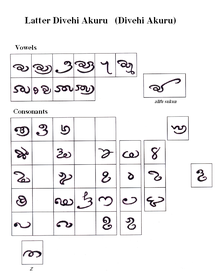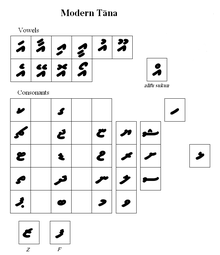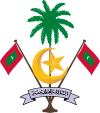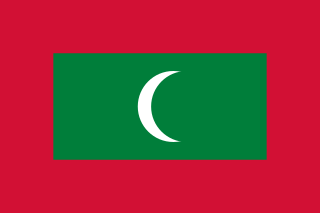
The Maldives, officially the Republic of Maldives, and historically known as Maldive Islands, is a country and archipelagic state in South Asia in the Indian Ocean. The Maldives is named after the main island and capital, Malé. The Maldives is southwest of Sri Lanka and India, about 750 kilometres from the Asian continent's mainland. The Maldives' chain of 26 atolls stretches across the equator from Ihavandhippolhu Atoll in the north to Addu Atoll in the south.
Thaana, Tãnaa, Taana or Tāna is the present writing system of the Maldivian language spoken in the Maldives. Thaana has characteristics of both an abugida and a true alphabet, with consonants derived from indigenous and Arabic numerals, and vowels derived from the vowel diacritics of the Arabic abjad. Maldivian orthography in Thaana is largely phonemic.
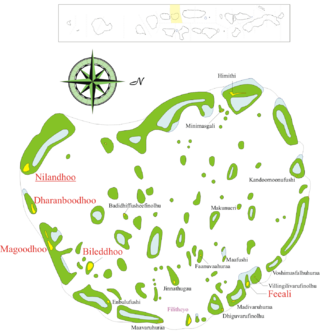
Faafu Atoll is an administrative division of the Maldives. It corresponds to the natural atoll of the same name.
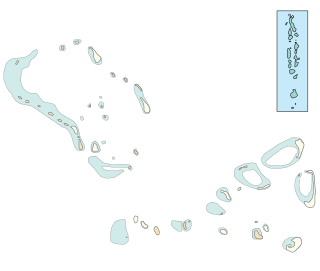
Haa Alif Atoll - officially referred as Thiladhunmathi Uthuruburi is the northernmost administrative division of the Maldives.
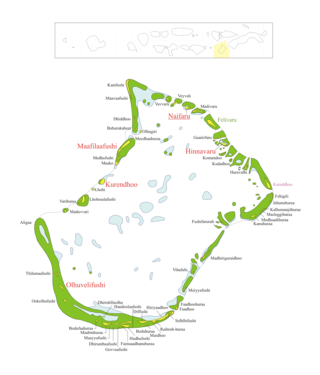
Lhaviyani Atoll is an administrative division of the Maldives. Its abbreviation is Lh.
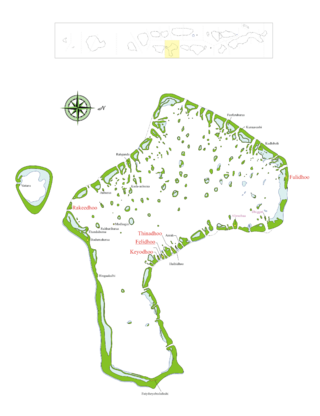
Vaavu Atoll is an administrative division of the Maldives, comprising the natural atolls of Felidhu Atoll and the Vattaru Reef.

Mulaku Atoll or Meemu Atoll(މުލަކަތޮޅު) is an administrative division of the Maldives. It corresponds to the natural atoll of the same name, also known as Mulak Atoll or 'Mulakatolhu'.
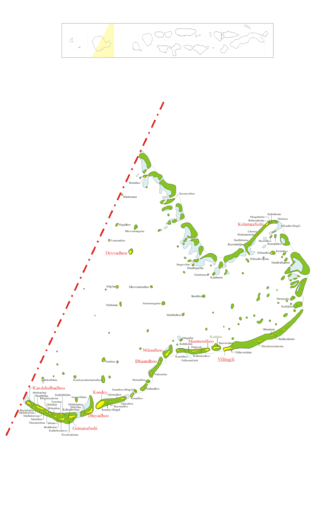
Gaafu Alifu is an administrative division of the Maldives created on February 8, 1962, when Huvadhu Atoll was divided into two districts. Gaafu Alifu corresponds to the northeastern section of this large natural atoll north of the line extending between the channels of Footukandu and Vaarulu Kandu. The capital of this district is Vilingili.

Gaafu Dhaalu is an administrative district of the Maldives formed by the southwestern section of Huvadhu Atoll. It was created on February 8, 1962, when Huvadhu Atoll was divided into two districts. Gaafu Dhaalu corresponds to the Southwestern section of this large natural atoll, south of the line extending between the channels of Footukandu and Vaarulu Kandu. The capital of this region is Thinadhoo (Thenadhoo). There are 153 islands in this district, 10 of which are inhabited. This district is located about 340 kilometers south of the capital Malé.

Gnaviyani Atoll is one of the administrative divisions of the Maldives corresponding to the natural atoll, Fuvahmulah. Surfacewise this is the smallest administrative unit in the Maldives, situated on the Equatorial Channel between Huvadhu Atoll and Addu Atoll.
Dhanbidhoo or Dambidū is one of the inhabited islands of Haddummati Atoll, administrative code Laamu.

Isdhoo or Isdū is one of the inhabited islands of Haddhunmathi Atoll, administrative code Laamu part of Maldives in the Indian Ocean.

Dhives Akuru, later called Dhivehi Akuru is a script formerly used for the Maldivian language. The name can be alternatively spelled Dives Akuru or Divehi Akuru using the ISO 15919 Romanization scheme, as the "d" is unaspirated.

Haddhunmathi or LaamuAtoll is an administrative division of the Maldives. The administrative capital is Fonadhoo Island. It corresponds to the natural atoll of the same name. It is mostly rimmed by barrier reefs, the broadest of which are topped by islands. There are many islands along its eastern and southern boundaries. This atoll is quite regular excepting for the projection of the reef at its NE corner. It closely resembles Kolhumadulhu, its neighbour further north. Owing to its typical atoll shape, it differs in no respect from atolls in the Pacific Ocean, save for its greater size. Its reefs are generally of little breadth, with no signs of vilu, except for its eastern fringes which are covered with islands that are quite large by Maldivian standards. The lagoon is comparatively open, containing scattered shoal patches; the bottom is muddy and the average depth is from 30 to 34 fathoms.

Lōmāfānu are Maldivian waqf grants in the form of copper plates on which inscriptions have been engraved. Many ancient Maldivian historical texts are found only in lōmāfānu form, with the oldest of the plates dating from the twelfth century AD. The Divehi script used on the plates was named "Eveyla Akuru" by H. C. P. Bell, who claimed that it resembled medieval Sinhala script.
Dhivehi Latin or Maldivian Latin, known colloquially as Malé Latin or Nasiri Latin, is a Latin Maldivian alphabet briefly mandated in the Maldives from 1976, but the country reverted to the native Thaana and Arabic alphabets in 1978. Maldivian Latin is still widely used in non-academic literature for romanizing Maldivian, however its rules are not strictly adhered to by most Maldivians.

The letter Shaviyani is the second letter of the Thaana abugida - the writing system used in the Dhivehi language of the Maldives and Minicoy Island.
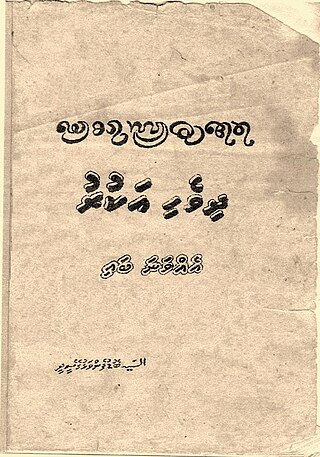
Bodufenvalhugey Sidi or Assayyidhu Bodufenvalhugey Seedhee (1888-1970), was a Maldivian intellectual and writer.

Maldivian, also known by its endonym Dhivehi or Divehi, is an Indo-Aryan language spoken in the South Asian island country of Maldives and on Minicoy Island, Lakshadweep, a union territory of India.

The Sultanate of Maldive Islands was an Islamic monarchy that controlled the Maldives for 815 years (1153–1968), with interruption.


